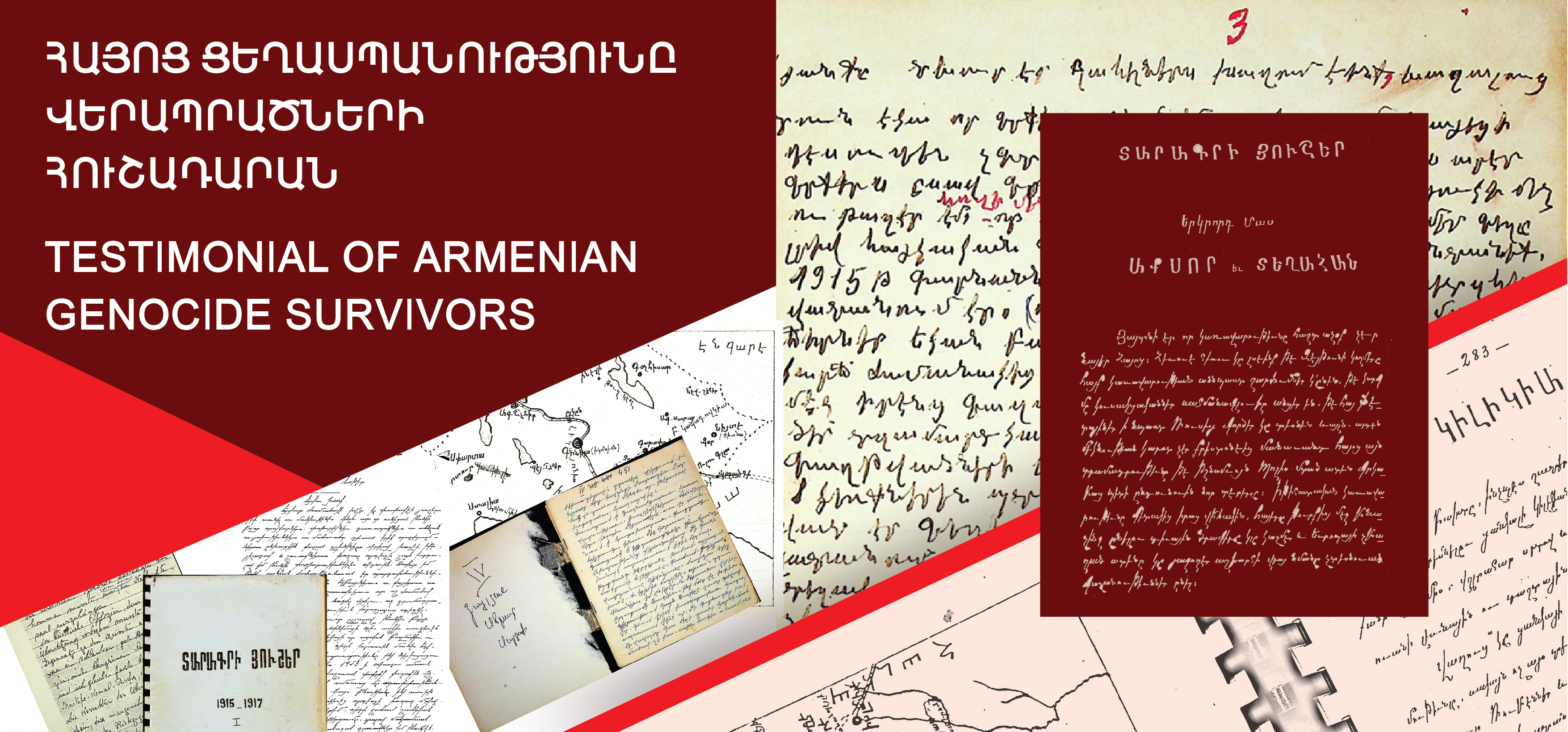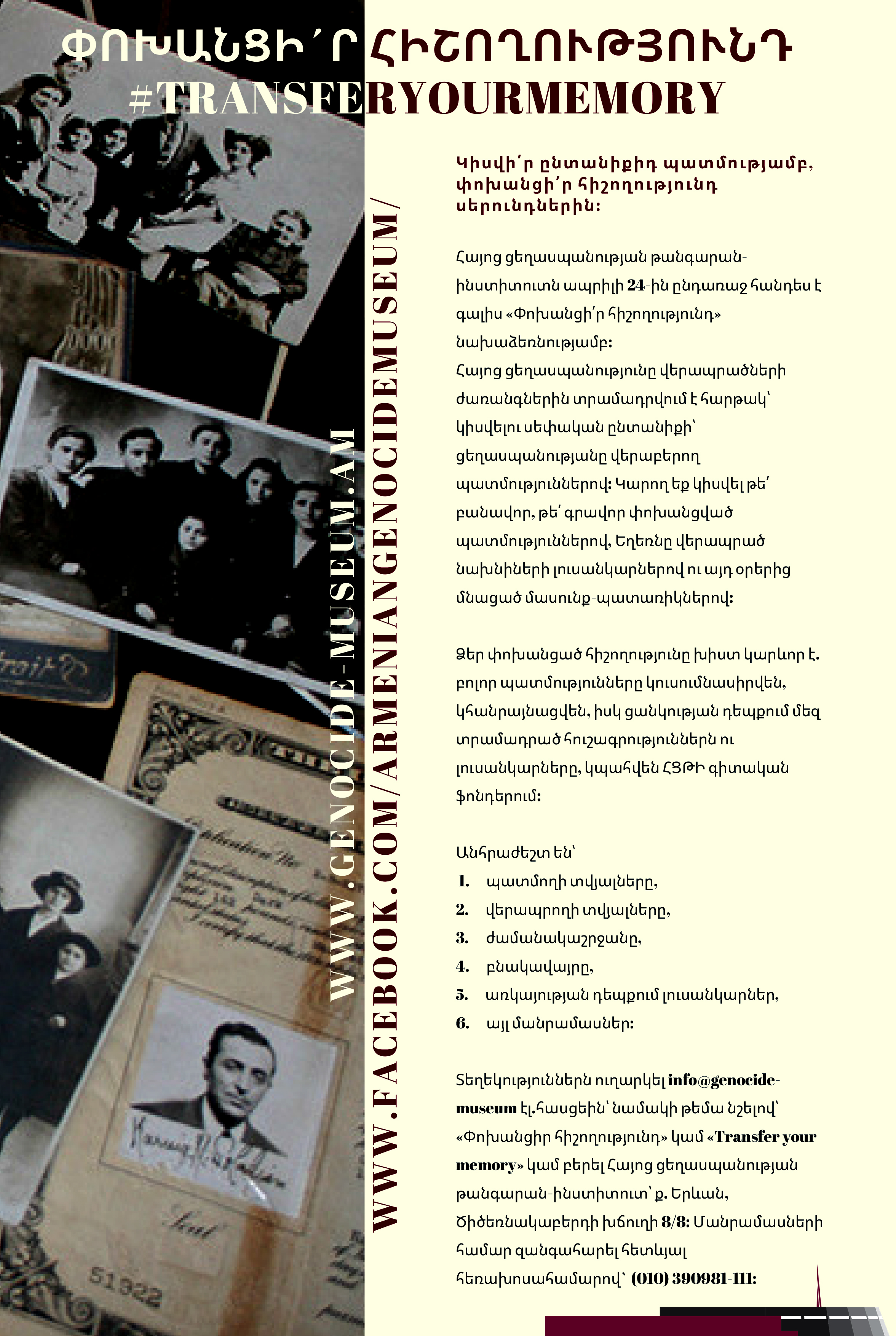News |
THE STORY OF THE BERBERYAN FAMILY OF BOGHAZLIAN

Veronica Berberyan’s family, Yerevan, 1954
On the first row - Alexan Mkrtchyan (from left to right, Veronica’s husband), Flora (Veronica’s mother), Veronica, on the second row (from left to right), Nerses, Sargis, Vardush
The Berberyan family was one of the large Armenian families of Boghazlian village in Yozgat province. On the eve of 1915, the population of Boghazlian was comprised of 700 Armenian families and 400 Turkish families. The priest of the local Surb Astvatsatsin Church (built 1865), Father Hakob (Nerses), was the elder of the Berberyan family. As he was born when his father was 80 years old, his birth was considered a gift from God, and the child was destined for religious life. Nerses Berberyan was ordained a priest, receiving the name Hakob, and served in the Surb Astvatsatsin Church.
Father Hakob’s wife was named Narik. They had five children: Gaspar (1890-1925), Anna (1892-1960s), Harutyun (1894-1978), Nazeli (1898-till 1915), Khach’er (1901-1960s). It was Veronica, the daughter of Gaspar and Flora Berberyan (born in 1905 or 1906), who wrote the story of her family.
Until 1914, due to the lack of a girls’ school in Boghazlian, Veronica was educated by her grandfather, Father Hakob. At the outbreak of WWI, Gaspar enlisted in the army, first as the chief doctor’s secretary of the first Dardanelles Hospital, then in 1920, as a member of the army of Kazim Karabekir, the commander of the Eastern Front, which marched towards Eastern Armenia. Avoiding military service, Gaspar settled down in Nakhichevan, working as a scribe and translator. He never returned to Turkey.
The massacres of Armenians in Boghazlian began in July 1915. Arrests and tortures of Armenian men began under the pretext of searching for hidden weapons. On 5 July, 350 men were arrested in Boghazlian, and the next day 300 were rounded up, including Father Hakob. They were tied up and taken to a gorge called Gharakoch’, where they were stripped naked, robbed of their money and jewelry, and then killed with sickles, hatchets, daggers, bayonets and rocks. Father Hakob was beheaded and the perpetrators had fun throwing his head to each other.
In February 1916, the second wave of massacres begins in Boghazlian, to which a large number of women and children fell victim; the latter were loaded into carts, taken to the nearby Qeller Valley, and were massacred. The Kaymakam of Boghazlian, Mehmet Kemal, played a special role in the organization of the massacres. He was one of those few who on April 8, 1919, were found guilty by the Court Martials in Constantinople for armed attacks on the Armenian population, robbery and premeditated murder. He was hanged in Beyazid Square in Istanbul on April 10. In a speech before his death, Kemal declared himself innocent, considering himself worthy for a monument, and not the gallows.
Some members of the Berberyan family survived the genocide thanks to Gaspar who was a high-ranking officer in the Ottoman army; the inscription “protected by the state” was posted on the gate of the family’s house. Harutyun Berberyan survived as he was a skilled hairdresser and his services were sought after by the local Turkish officials. Following the disappearance of his older brother and the brutal murder of his father, Harutyun took on the responsibility of taking care of the family. Endangering the safety of his own family, Harutyun tried his best to help the local Armenians. He used to bring home orphaned children; he took care of them and taught them his craft. One of those orphans was Veronica’s childhood friend Siranush, whose parents and all relatives were killed. Siranush lived in Turkey for several years; she forgot her mother tongue and religion. The Berberyans worked hard to return Siranush back to her Armenian identity; she later married Khach’er Berberyan. Siranush and Khach’er moved to Beirut in the 1920s and started a new life. They had two daughters and a son.
Harutyun and Khach’er became members of the Armenian National Union, which was established on 5 February 1919 by Armenian survivors from Boghazlian. The union was mainly engaged in saving Armenian orphans and providing them with care and shelter. From the moment of its establishment, the members of Boghazlian’s Armenian National Union were constantly persecuted and subjected to violence.
In 1925, the Berberyans moved to Constantinople, then to Batumi and Nakhichevan, where they were reunited with Gaspar. Their family reunion, however, was short-lived; Gaspar died a year and a half later
 Fr. Hakob: Armenian Genocide Martyr
Fr. Hakob: Armenian Genocide Martyr
Armenian Genocide Museum-Institute
 Excerpt from Veronica Berberyan's memory
Excerpt from Veronica Berberyan's memory
Armenian Genocide Museum-Institute
|
|
DONATE |

TO KEEP THE MEMORY OF THE ARMENIAN GENOCIDE ALIVE
Special Projects Implemented by the Armenian Genocide Museum-Institute Foundation
|
COPYRIGHT |

|
AGMI BOOKSTORE |

The Armenian Genocide Museum-Institute’s “World of Books”
|
TESTIMONIAL OF ARMENIAN GENOCIDE SURVIVORS |

THE AGMI COLLECTION OF UNPUBLISHED MEMOIRS
|
ONLINE EXHIBITION |

SELF-DEFENSE IN CILICIA DURING THE ARMENIAN GENOCIDE
DEDICATED TO THE CENTENNIAL OF THE SELF-DEFENSE BATTLES OF MARASH, HADJIN, AINTAB
|
LEMKIN SCHOLARSHIP |

AGMI ANNOUNCES 2024
LEMKIN SCHOLARSHIP FOR FOREIGN STUDENTS
|
TRANSFER YOUR MEMORY |

Share your family story,
Transfer your memory to generations.
On the eve of April 24, the Armenian Genocide Museum-Institute undertakes an initiative “transfer your memory”.
|
|





